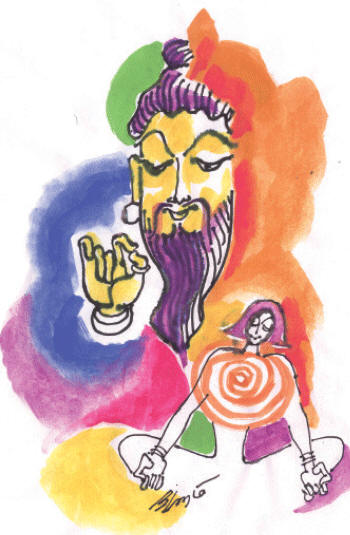ManCanBecomeGod06
Posted Date : 06:00 (23/12/2014)
Author: Kaivalliya Navanītham
P.N. Parasuraman. Images:
Nataṉam
Spiritual Instructions knowing the recipient.
Having instructed the disciples on three kinds of Dīkṣa, haven’t we seen
his continued announcement, ‘I will teach you the way to remove the
misery of rebirth? If followed, your misery of rebirth will come to an
end.
One man had a big problem: he needed Rs. 100,000 immediately. No one
came forward. What will be the
situation, if someone says, ‘Giving you the needed money, I will remove
your hardsho? Likewise, when one is
distressed not finding relief from the misery of rebirth, what will be
one’s joy, if someone says, ‘I will show the way.’
Hearing the swords of Gurunāthar, the disciple’s joy knew no bounds. It
was like the coiffure on fire and the man plunging into the cool waters
of a lake. The disciple was that joyous. His body and soul were
blissful.
The disciple fell at the feet of Gurunāthar and paid homage, saying,
“You said that paying heed to you will dissipate my misery. Though I may
not be a heeder, why did you not take me as your spiritual servitor and
stop me from my erroneous ways, with compassion? You said there is a way
for relief from the misery of rebirth. He implored Gurunāthar to show
the way and save him, his servitor.”
We see his hastiness to find a quick relief from the disciples’ words.
It also tells only Gurunāthar can show him the way out of misery of
rebirth.
Will Gurunāthar stay still, hearing the plea of the disciple?
He instructed him.
Why, could he not have refused instructing him? The answer is
rejection is not the option. The Sāstraic caution is that no one should
withhold his knowledge or skill from a deserving pupil. That lapse will
engender the Guru’s birth as Rākṣasa
according to Sastras. What we know, we should put in practice. We should
teach it to the next man. The important point here is the deserving and
qualified person.
Instructions at IAS level should not be offered to a second-grade
student and vice versa. Accordingly, upon inquiry from a capable
disciple, Gurunāthar began instructing him.
The disciple has subdued his desires, as discovered by the Guru. For the
disciple to attain
Ātma-Svarūpam,
Gurunāthar began religious instructions to that Jīva.
Only after finding out that the disciple subdued his increasing desires,
Guru gave instructions. That is after knowing the disciple was
developed and progressive in his pursuit.
Though it is said he instructed him after the disciple was vetted
properly, there is a wasp story between vetting and instruction. That is
an example.
|
அடங்கிய விருத்தியான் என்று |
|
அறிந்தபின் செறிந்த மண்ணின் |
|
குடம்பையுள் புழுமுன் ஊதும் |
|
குளவியின் கொள்கை போலத் |
|
தொடங்கிய குருவும் ஆன்ம |
|
சொரூபமே மருவ வேண்டி |
|
உடம்பினுள் சீவனைப் பார்த்து |
|
உபதேசம் ஓதுவாரே |
|
(கைவல்லிய
நவநீதம்-11) |
There was a worm in a mud
nest. The wasp stung the worm multiple times. Unable to bear the pain
from the stings, the buzzing of the wasp itself made the worm think of
the wasp. Over days, the worm morphs into a wasp. Likewise, Gurunāthar
makes a disciple mature, gives him Jñāṉa Upadeśam and raises him to his
level. The line in the poem says, “The wasp buzzing before the worm
inside the mud nest.’
The next line says, “Seeing the Jīva (of the disciple), he instructed.”
The buzzing of the wasp and the instructions of Gurunāthar draw a
parallel.
The wasp buzzes only before the worm and not before the mud nest.
Likewise, Gurunāthar offers instructions before the Jīva (soul of the
disciple) and not before his body. Guru of that high a caliber still
offers Upadeśam to the deserving disciple.
It continues.
